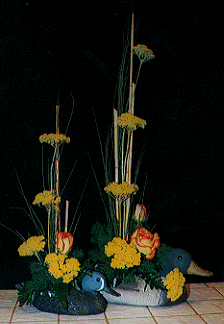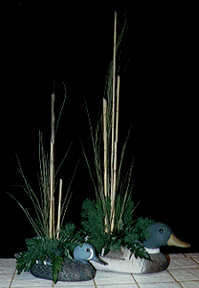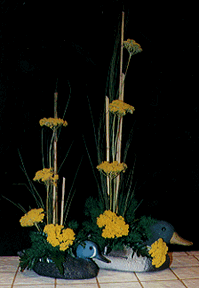|
Rittners School Of Floral Design
In Boston Presents.....
 How To Make A
Ducks Floral Design How To Make A
Ducks Floral Design
I was once asked by someone if it were possible to describe American Floral Designing in a nutshell.
My answer was "eclectic."
In the US we have a variety of interests, tastes and lifestyles. Our floral art reflects the myriad of possibilities inherent in our culture. It is an echo of who we are, where our interests lie, and where we are going.
This design is a good case in point.
Many folks love the outdoors, and nature. Some enjoy just looking and experiencing it. Others like to go out hunting......Some of us love nature as an escape from urban or suburban lifestyles. Others enjoy living in remote areas. Regardless of your particular preferences, this design provides a rather interesting approach.
What You Will Need
- Duck containers
- Foam
- Baker fern
- Ming fern
- Scotch broom
- Yarrow
- Roses
- River cane
 The base for this design is actually several plastic containers. This makes it very easy to simply place the foam into the bases, and then stylize our creation. Alternatively, should you use wooden containers or wooden decoys, you would have to either place a small plastic container into any available opening, or attach small cages of foam to the back sides of the bases. The base for this design is actually several plastic containers. This makes it very easy to simply place the foam into the bases, and then stylize our creation. Alternatively, should you use wooden containers or wooden decoys, you would have to either place a small plastic container into any available opening, or attach small cages of foam to the back sides of the bases.
We start the design by covering our mechanics with foliage. Take care not to overdo it. If you place too much foliage into the base, you won't see the ducks themselves. That would take away from the design.....The foliages are mixed. Notice that both baker fern as well as a little ming fern are being used. It is quite common practice for American floral designers to mix foliages in their designing. It provides interesting contrast in textures......
To establish height in the design we are using river cane. River cane (also known as bamboo) is very attractive, natural in feeling, and it is easy to cut (compared to other materials such as plastic rods, etc. which give more of a high tech look).
The river cane gives the design an overall skeletal structure within which we will work, but it also makes the design feel a bit rigid. To soften that effect we add some of our scotch broom to this composition.
Scotch broom is a great foliage. It is available throughout most of the year, (with the exception of the summer). It is a unique foliage in that unlike baker fern or ming fern (which are good for covering mechanics), scotch broom can be used quite effectively to establish strong line and form.........Yet it still imparts a relaxed, natural effect!!!
Note that at this point we pretty much see the parameters defining this arrangement, yet not a flower has been placed so far............
Let's get into our flower placement...........

Let's start with our yarrow.
Yarrow, also known as Achillea Filipendulina, (How's that for a mouthful!!) is a great flower. It is available pretty much throughout the year. If you can't get it in its fresh form, you can always get it dried. Purchased fresh,it has a nice fragrance. It comes both in the golden color and also in reds as well. If you buy fresh yarrow, you will find that it dries quite easily. It is a great flower to use in mixed arrangements. I also especially enjoy also using it for fall, and also for Christmas designs as well.
Let's start at the top of our river cane, placing yarrow into each of our two bases as shown.

Continue adding yarrow down the length of the river cane.
In the smaller design the last two pieces are placed with one a little higher, the other a little lower, down on the baseline of the design.
In the larger design four pieces of yarrow extend our eye from the top of the design down to the base. A final piece of yarrow extends to the right, slightly out to the front.

The design is easily completed with the addition of a few roses......
This pair of designs can be used in many ways.
- It is a great design to decorate any home with a rustic feeling to it.
- It is a great design for any home with a country look.
- It is a great design to place in any store looking for a rustic or country look.
- It can be used on a side board.
- It could be placed in or on a bookcase. (with care not to wet the furniture).
- It can be used in a kitchen or bathroom.
- It can be used as a mantel decoration.
- It can be used as a gift for the person who loves the outdoors.
- It can be used for a function, as table decorations (eg. imagine two, three or four of these clustered in the middle of a table, or making their way down the center of a long table, or used on a buffet table).
- It can be stylized as a one sided design as shown here.
- It can be stylized as a two sided design.
- It can be made using live materials or with dried and silk for greater longevity.
We hope that you really enjoyed this brief floral design lesson. At
Rittners Floral School in Boston we provide
floral design instruction that includes a wide range of different
styles and techniques. Please come and take one of our hands-on
workshop programs!!
Floral Education Center
returns you to our Floral Education Center.
Your Webmaster is Dr. Steve Rittner, who may be reached at Stevrt@tiac.net.
All photographs and text on
this page are Copyright - Rittners School,
and may not be reproduced, or used for any commercial purposes.
|